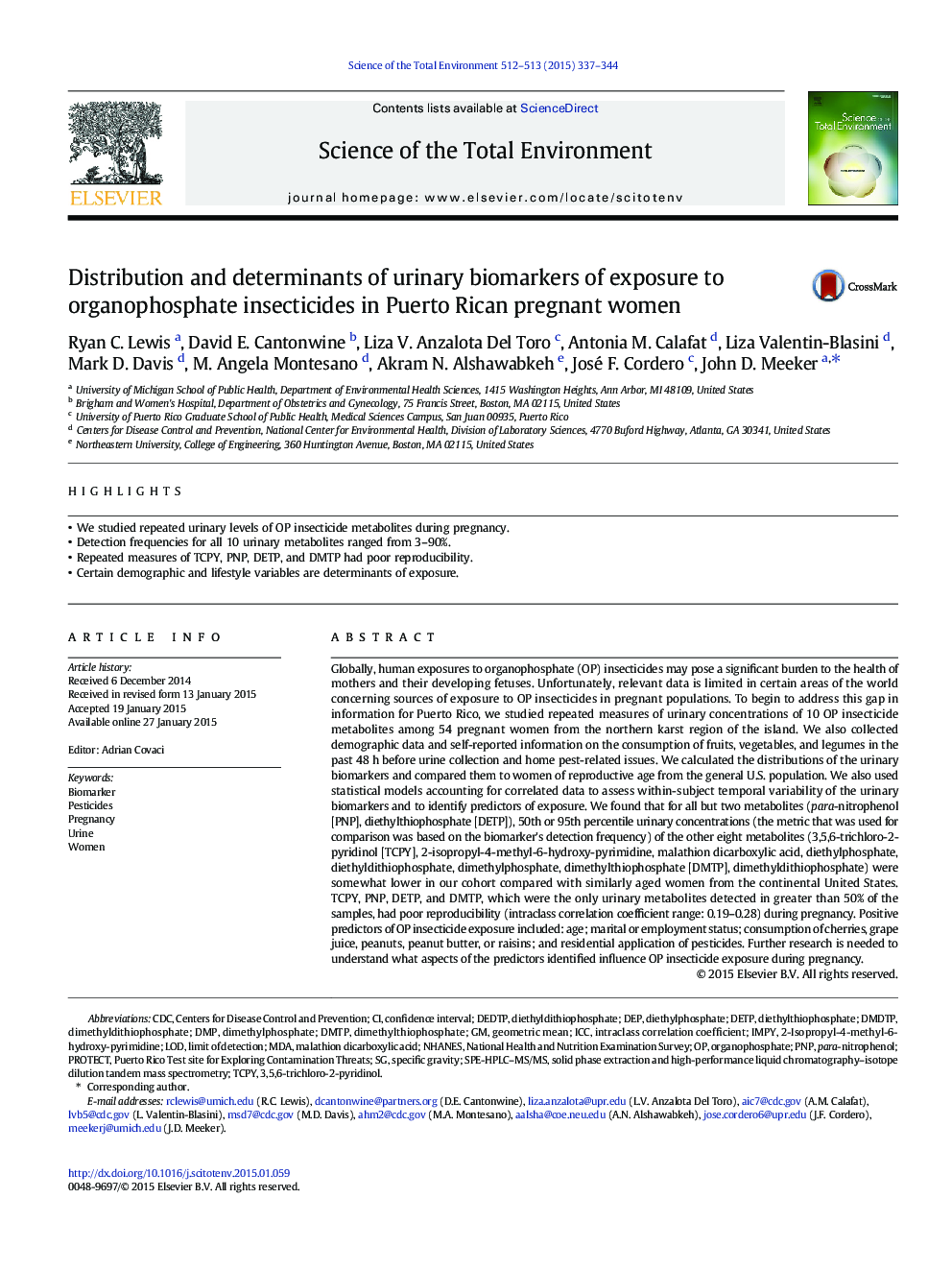| کد مقاله | کد نشریه | سال انتشار | مقاله انگلیسی | نسخه تمام متن |
|---|---|---|---|---|
| 6327214 | 1619765 | 2015 | 8 صفحه PDF | دانلود رایگان |
عنوان انگلیسی مقاله ISI
Distribution and determinants of urinary biomarkers of exposure to organophosphate insecticides in Puerto Rican pregnant women
ترجمه فارسی عنوان
توزیع و تعیین کننده های بیومارکرهای ادرار قرار گرفتن در معرض حشره کش ها در زنان باردار پورتوریک
دانلود مقاله + سفارش ترجمه
دانلود مقاله ISI انگلیسی
رایگان برای ایرانیان
کلمات کلیدی
DMPTCPyNHANESDMDTPDMTPPNPDETPDEDTPDEPCDCMDAIMPYICC3,5,6-Trichloro-2-pyridinol - 3،5،6-تری کلرو-2-پیریدینولpara-nitrophenol - para-nitrofenolpesticides - آفتکشهاUrine - ادرار Organophosphate - ارگانوفسفاتPregnancy - بارداریNational Health and Nutrition Examination Survey - بررسی بهداشت و تغذیه ملیBiomarker - بیومارکرLOD یا Limit of detection - حد تشخیصDiethyldithiophosphate - دی اتیل دی اتیفا فسفاتdiethylthiophosphate - دی اتیل فسفاتdiethylphosphate - دی اتیلفسفاتdimethylthiophosphate - دی متیل تیتو فسفاتDimethyldithiophosphate - دی متیل دی متیل فسفاتdimethylphosphate - دی متیل فسفاتWomen - زنintraclass correlation coefficient - ضریب همبستگی داخل کلاسیconfidence interval - فاصله اطمینانPROTECT - محافظتlimit of detection - محدودیت تشخیصCenters for Disease Control and Prevention - مراکز کنترل و پیشگیری از بیماریGeometric mean - میانگین هندسیSpecific gravity - وزن مخصوص
موضوعات مرتبط
علوم زیستی و بیوفناوری
علوم محیط زیست
شیمی زیست محیطی
چکیده انگلیسی
Globally, human exposures to organophosphate (OP) insecticides may pose a significant burden to the health of mothers and their developing fetuses. Unfortunately, relevant data is limited in certain areas of the world concerning sources of exposure to OP insecticides in pregnant populations. To begin to address this gap in information for Puerto Rico, we studied repeated measures of urinary concentrations of 10 OP insecticide metabolites among 54 pregnant women from the northern karst region of the island. We also collected demographic data and self-reported information on the consumption of fruits, vegetables, and legumes in the past 48Â h before urine collection and home pest-related issues. We calculated the distributions of the urinary biomarkers and compared them to women of reproductive age from the general U.S. population. We also used statistical models accounting for correlated data to assess within-subject temporal variability of the urinary biomarkers and to identify predictors of exposure. We found that for all but two metabolites (para-nitrophenol [PNP], diethylthiophosphate [DETP]), 50th or 95th percentile urinary concentrations (the metric that was used for comparison was based on the biomarker's detection frequency) of the other eight metabolites (3,5,6-trichloro-2-pyridinol [TCPY], 2-isopropyl-4-methyl-6-hydroxy-pyrimidine, malathion dicarboxylic acid, diethylphosphate, diethyldithiophosphate, dimethylphosphate, dimethylthiophosphate [DMTP], dimethyldithiophosphate) were somewhat lower in our cohort compared with similarly aged women from the continental United States. TCPY, PNP, DETP, and DMTP, which were the only urinary metabolites detected in greater than 50% of the samples, had poor reproducibility (intraclass correlation coefficient range: 0.19-0.28) during pregnancy. Positive predictors of OP insecticide exposure included: age; marital or employment status; consumption of cherries, grape juice, peanuts, peanut butter, or raisins; and residential application of pesticides. Further research is needed to understand what aspects of the predictors identified influence OP insecticide exposure during pregnancy.
ناشر
Database: Elsevier - ScienceDirect (ساینس دایرکت)
Journal: Science of The Total Environment - Volumes 512â513, 15 April 2015, Pages 337-344
Journal: Science of The Total Environment - Volumes 512â513, 15 April 2015, Pages 337-344
نویسندگان
Ryan C. Lewis, David E. Cantonwine, Liza V. Anzalota Del Toro, Antonia M. Calafat, Liza Valentin-Blasini, Mark D. Davis, M. Angela Montesano, Akram N. Alshawabkeh, José F. Cordero, John D. Meeker,
